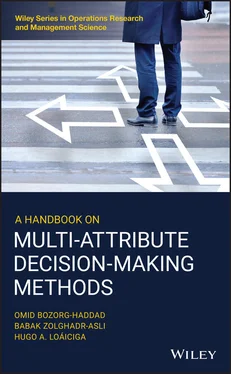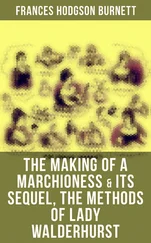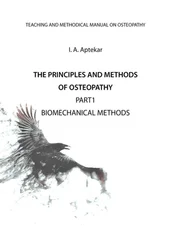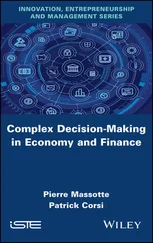16 Custer, R.L., Scarcella, J.A., and Stewart, B.R. (1999). The modified Delphi technique: a rotational modification. Journal of Career and Technical Education 15 (2): 50–58.
17 Dalkey, N. and Helmer, O. (1963). An experimental application of the Delphi method to the use of experts. Management Science 9 (3): 458–467.
18 Deng, J. (1989). Introduction to grey system theory. The Journal of Grey System 1 (1): 1–24.
19 Fan, Z.P. (1996). Complicated multiple attribute decision making: theory and applications. Ph.D. Dissertation. Northeastern University. Shenyang, China.
20 Hansen, P. and Ombler, F. (2008). A new method for scoring additive multi‐attribute value models using pairwise rankings of alternatives. Journal of Multi‐Criteria Decision Analysis 15 (3–4): 87–107.
21 Hwang, C.L. and Yoon, K. (1981). Methods for multiple attribute decision making. In: Multiple Attribute Decision Making: Lecture Notes in Economics and Mathematical Systems (eds. C.L. Hwang and K. Yoon), 58–191. Heidelberg, Germany: Springer Publication Company.
22 Jeffreys, I. (2004). The use of compensatory and non‐compensatory multi‐criteria analysis for small‐scale forestry. Small‐Scale Forest Economics, Management and Policy 3 (1): 99–117.
23 Kahneman, D. and Tversky, A. (1984). Choices, values, and frames. American Psychologist 39 (4): 341.
24 Kiesler, S. and Sproull, L. (1992). Group decision making and communication technology. Organizational Behavior and Human Decision Processes 52 (1): 96–123.
25 Kleindorfer, P.R., Kunreuther, H., and Schoemaker, P.J. (1993). Decision Sciences: An Integrative Perspective. Cambridge, UK: Cambridge University Press.
26 Malczewski, J. (1999). GIS and Multicriteria Decision Analysis. New York, NY: Wiley.
27 Mendoza, G.A. and Martins, H. (2006). Multi‐criteria decision analysis in natural resource management: a critical review of methods and new modelling paradigms. Forest Ecology and Management 230 (1–3): 1–22.
28 Mladineo, N., Margeta, J., Brans, J.P., and Mareschal, B. (1987). Multicriteria ranking of alternative locations for small scale hydro plants. European Journal of Operational Research 31 (2): 215–222.
29 Opricovic, S. (1998). Multicriteria optimization of civil engineering systems. Ph.D. Thesis. Faculty of Civil Engineering. Belgrade, Serbia.
30 Pearl, J. (1996). Decision making under uncertainty. ACM Computing Surveys 28 (1): 89–92.
31 Rezaei, J., Wang, J., and Tavasszy, L. (2015). Linking supplier development to supplier segmentation using best‐worst method. Expert Systems with Applications 42 (23): 9152–9164.
32 Rieger, M.O. and Wang, M. (2006). Cumulative prospect theory and the St. Petersburg paradox. Economic Theory 28 (3): 665–679.
33 Roy, B. (1978). ELECTRE III: Un algorithme de classement fondé sur une représentation floue des préférences en présence de critères multiples. Cahiers du Centre d’Etudes de Recherche Opérationnelle 20 (1): 3–24.
34 Roy, B. and Bertier, P. (1971). La méthode ELECTRE II: Note de travail 142. SEMA‐METRA. Metra International.
35 Roy, B. and Hugonnard, J.C. (1982). Ranking of suburban line extension projects on the Paris metro system by a multicriteria method. Transportation Research Part A: General 16 (4): 301–312.
36 Saad, G.H. (2001). Strategic performance evaluation: descriptive and prescriptive analysis. Industrial Management and Data Systems 101 (8): 390–399.
37 Saaty, T.L. (1977). A scaling method for priorities in hierarchical structures. Journal of Mathematical Psychology 15 (3): 234–281.
38 Saaty, T.L. (1996). Decision Making with Dependence and Feedback: The Analytic Network Process. Pittsburgh, PA: RWS Publications.
39 Santos, L.R. and Rosati, A.G. (2015). The evolutionary roots of human decision making. Annual Review of Psychology 66: 321–347.
40 Shannon, C.E. (1948). A mathematical theory of communication. Bell System Technical Journal 27 (3): 379–423.
41 Tversky, A. and Kahneman, D. (1986). Rational choice and the framing of decisions. Journal of Business: S251–S278.
42 Tzeng, G.H. and Huang, J.J. (2011). Multiple Attribute Decision Making: Methods and Applications. Boca Raton, FL: CRC Press.
43 Velasquez, M. and Hester, P.T. (2013). An analysis of multi‐criteria decision making methods. International Journal of Operations Research 10 (2): 56–66.
44 Vincke, J.P. and Brans, P. (1985). A preference ranking organization method: the PROMETHEE method for MCDM. Management Science 31 (6): 647–656.
45 Vroom, V.H. and Jago, A.G. (1974). Decision making as a social process: normative and descriptive models of leader behavior. Decision Sciences 5 (4): 743–769.
46 Weber, E.U. and Coskunoglu, O. (1990). Descriptive and prescriptive models of decision‐making: implications for the development of decision aids. IEEE Transactions on Systems, Man, and Cybernetics 20 (2): 310–317.
47 Xu, X. (2001). The SIR method: a superiority and inferiority ranking method for multiple criteria decision making. European Journal of Operational Research 131 (3): 587–602.
48 Zolghadr‐Asli, B., Bozorg‐Haddad, O., and Chu, X. (2018a). Chapter 1: Introduction. In: Advanced Optimization by Nature‐Inspired Algorithms. Singapore: Springer International Publishing AG.
49 Zolghadr‐Asli, B., Bozorg‐Haddad, O., and Chu, X. (2018b). Crow search algorithm (CSA). In: Advanced Optimization by Nature‐Inspired Algorithms. Singapore: Springer.
50 Zolghadr‐Asli, B., Bozorg‐Haddad, O., and Chu, X. (2018c). Dragonfly algorithm (DA). In: Advanced Optimization by Nature‐Inspired Algorithms. Singapore: Springer.
51 Zolghadr‐Asli, B., Bozorg‐Haddad, O., and Chu, X. (2018d). Krill herd algorithm (KHA). In: Advanced Optimization by Nature‐Inspired Algorithms. Singapore: Springer.
52 Zolghadr‐Asli, B., Bozorg‐Haddad, O., and Loáiciga, H.A. (2017). Discussion of ‘Optimization of Phenol Removal Using Ti/PbO 2 Anode with Response Surface Methodology’ by C. García‐Gómez, JA Vidales‐Contreras, J. Nápoles‐Armenta, and P. Gortáres‐Moroyoqui. Journal of Environmental Engineering 143 (9): 07017001.
2 Simple Weighting Methods: Weighted Sum and Weighted Product Methods
2.1 Introduction
To reach a better understanding of any decision‐making problem, one must employ information‐gathering methods, including but not limited to surveys, questionnaires, examination, and sampling, to collect as much practical information as possible. Eventually, such attempts increase the chance of choosing the most suitable alternative, that would better reflect the needs and interests of the stakeholders of the MADM problem at hand (Tzeng and Huang 2011).
From the MADM point of view, the gathered information regarding the problem in question is generally represented in a matrix form, commonly referred to as the decision‐matrix. Based on the decision‐matrix, the decision‐maker can anticipate the stakeholders' desires and preferences, which eventually lead to choosing the most suitable available option through a mathematically supported framework. The choosing process proceeds and their assumptions are what distinguishes between the MADM methods.
A MADM problem is composed of a set of alternatives, which are the feasible discrete solutions available to the decision‐maker, and a set of evaluation criteria, which are the instruments through which the stakeholders describe their objective. Subsequently, a decision‐matrix in extended form is constructed based on the four following information sets (Yu 1990):
1 (1) The set of feasible alternatives, denoted by {ai | i = 1, 2, …, m}. Notice that each alternative represents a row in the decision‐matrix (D);
2 (2) The set of predefined evaluation criteria denoted by {cj | j = 1, 2, …, n}. Each criterion represents a column in the decision‐matrix (D);
Читать дальше












